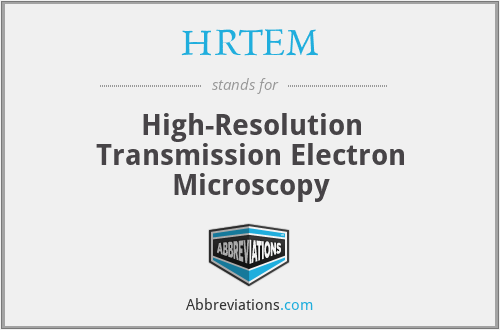We've got 17 shorthands for microscopy, electron, transmission »
Acronyms that contain the term microscopy, electron, transmission
What does microscopy, electron, transmission mean? This page is about the various possible meanings of the acronym, abbreviation, shorthand or slang term: microscopy, electron, transmission.
| Term | Definition | Rating |
|---|---|---|
| HRTEM | High-Resolution Transmission Electron Microscopy | |
| STEM | Scanning Transmission Electron Microscopy | |
| XTEM | Cross-sectional Transmission Electron Microscopy | |
| CTEM | Conventional Transmission Electron Microscopy | |
| ATEM | Analytical Transmission Electron Microscopy | |
| CISTEM | Computational Imaging System for Transmission Electron Microscopy | |
| CISTEM | Computational Imaging System for Transmission Electron Microscopy | |
| EFTEM | Energy Filtered Transmission Electron Microscopy | |
| HRTEM | High Resolution Transmission Electron Microscopy | |
| PTEM | Platelet Transmission Electron Microscopy | |
| LTEM | Lorentz transmission electron microscopy | |
| TEM | Transmission electron microscopy | |
| ETEM | Environmental Transmission Electron Microscopy | |
| Cryo-TEM | Cryogenic transmission electron microscopy | |
| BF-TEM | Bright-field transmission electron microscopy | |
| STEM | Scanning Transmission Electron Microscopy | |
| TEM | Transmission Electron Microscopy |
What does microscopy, electron, transmission mean?
- microscopy, electron, transmission
- Transmission electron microscopy (TEM) is a microscopy technique in which a beam of electrons is transmitted through a specimen to form an image. The specimen is most often an ultrathin section less than 100 nm thick or a suspension on a grid. An image is formed from the interaction of the electrons with the sample as the beam is transmitted through the specimen. The image is then magnified and focused onto an imaging device, such as a fluorescent screen, a layer of photographic film, or a sensor such as a scintillator attached to a charge-coupled device. Transmission electron microscopes are capable of imaging at a significantly higher resolution than light microscopes, owing to the smaller de Broglie wavelength of electrons. This enables the instrument to capture fine detail—even as small as a single column of atoms, which is thousands of times smaller than a resolvable object seen in a light microscope. Transmission electron microscopy is a major analytical method in the physical, chemical and biological sciences. TEMs find application in cancer research, virology, and materials science as well as pollution, nanotechnology and semiconductor research, but also in other fields such as paleontology and palynology. TEM instruments have multiple operating modes including conventional imaging, scanning TEM imaging (STEM), diffraction, spectroscopy, and combinations of these. Even within conventional imaging, there are many fundamentally different ways that contrast is produced, called "image contrast mechanisms". Contrast can arise from position-to-position differences in the thickness or density ("mass-thickness contrast"), atomic number ("Z contrast", referring to the common abbreviation Z for atomic number), crystal structure or orientation ("crystallographic contrast" or "diffraction contrast"), the slight quantum-mechanical phase shifts that individual atoms produce in electrons that pass through them ("phase contrast"), the energy lost by electrons on passing through the sample ("spectrum imaging") and more. Each mechanism tells the user a different kind of information, depending not only on the contrast mechanism but on how the microscope is used—the settings of lenses, apertures, and detectors. What this means is that a TEM is capable of returning an extraordinary variety of nanometer- and atomic-resolution information, in ideal cases revealing not only where all the atoms are but what kinds of atoms they are and how they are bonded to each other. For this reason TEM is regarded as an essential tool for nanoscience in both biological and materials fields. The first TEM was demonstrated by Max Knoll and Ernst Ruska in 1931, with this group developing the first TEM with resolution greater than that of light in 1933 and the first commercial TEM in 1939. In 1986, Ruska was awarded the Nobel Prize in physics for the development of transmission electron microscopy.
Know what is microscopy, electron, transmission? Got another good explanation for microscopy, electron, transmission? Don't keep it to yourself!
Still can't find the acronym definition you were looking for? Use our Power Search technology to look for more unique definitions from across the web!
Citation
Use the citation options below to add these abbreviations to your bibliography.
Style:MLAChicagoAPA
"microscopy, electron, transmission." Abbreviations.com. STANDS4 LLC, 2024. Web. 26 Apr. 2024. <https://www.abbreviations.com/microscopy%2C%20electron%2C%20transmission>.


Discuss these microscopy, electron, transmission abbreviations with the community:
Report Comment
We're doing our best to make sure our content is useful, accurate and safe.
If by any chance you spot an inappropriate comment while navigating through our website please use this form to let us know, and we'll take care of it shortly.
Attachment
You need to be logged in to favorite.
Log In